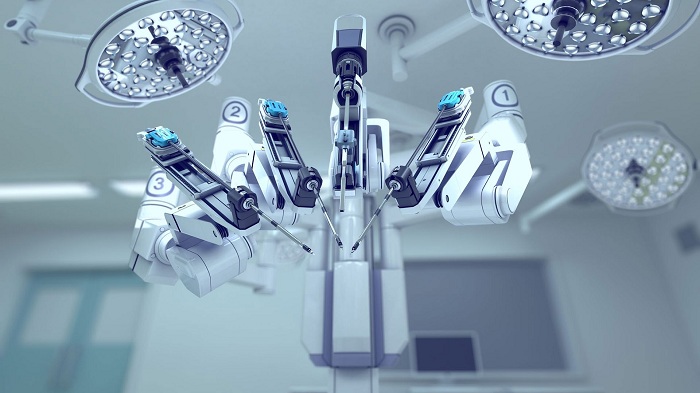How is it possible that a more expensive, more invasive and more time-consuming surgical option for minimally invasive GYN surgery – robotics – is quickly becoming the mainstream?
What happened to that laparoscopic procedure of the past that used fewer and smaller incisions, took less time to complete, had fewer complications and did not require a $2 million robot? Is it that robotics is that much better, or is it that effective corporate marketing to physicians and patients trumps better care?
Even more relevant, does it have to do with the focus and skill set of the OBGYN that requires the robot to complete GYN surgical procedures?
All four of these questions are relevant. The root of the problem is really in the last question, which goes directly to the point that the OBGYN is not a surgeon, but more like an obstetrician full-time and a GYN surgeon part-time.
There is no other “surgical” specialty like OBGYN. If you think about general surgery, orthopedic surgery or any other surgical specialty, surgery is the main focus of care. In OBGYN, however, obstetrics is the main focus of care, and surgery is not. It is not possible for any OBGYN not to practice obstetrics. Obstetrics is what the OBGYN does more than 50 percent of the time, and it is obstetrics that provides the OBGYN with his or her main source of income. The OBGYN would not survive without obstetrics, and in medicine, economics is becoming the dominant force directing the path of physicians, insurance companies and patients.
So back to robotics: how does a robotic procedure impact the patient, and why does the OBGYN perform robotics? While most OBGYNs using robotics need this device to perform a surgery in a minimally invasive fashion, non-robotic laparoscopic surgery performed by a GYN surgical specialist actually provides a faster recovery with lower complications. If a patient wants better quality of care, he or she would seek out a GYN surgical specialist, similar to the example of the general or orthopedic surgeon above, who perform only surgery and not obstetrics.
Why is this not happening? Patients initially seek out their obstetrician for obstetrics services. In the course of going through pregnancy, these patients develop a relationship with their OBGYN. The bond of trust that develops translates into the OBGYN providing surgical care when needed, such as for fibroids, endometriosis and other conditions.
What many patients do not realize, though, is that trust alone may not be enough when minimally invasive surgery is required. The OBGYN just does not have the surgical skills, patient volume and additional training of the surgical specialist. This is the reason why the OBGYN has not adopted or learned better standard non-robotic approaches to surgery.
To take this a step further, put yourselves into the shoes of a company that has developed a robotic system. This company is looking for applications for its robotic device. Certainly, a part-time surgeon, such as the OBGYN – who is performing a high volume of open surgeries, such as hysterectomy and myomectomy, with longer recovery time – becomes a great candidate for robotics.
What’s more, OBGYNs perform over 95 percent of all GYN procedures since they have developed a trust relationship with patients within their practice. If surgery is needed, these same patients look to their obstetrician to do what is best for their surgical care. If their OB says that they need open surgery, and there is no other way to perform the procedure, they will do open surgery. Likewise, if the OB says robotics is the way to go, so robotics it is.
All of this provides the manufacturer of the robot entry into the GYN surgical arena. Market directly to the patient the benefits of robotics over open surgery, and then market to the OBGYN this new device that allows them to do the surgery themselves, avoid open procedures and not have to send the patient out to a specialist for care (and be able to bill for it).
Patients will then request robotics from their OBGYN, and the OBGYNs will ask hospitals to buy the robot. Companies also market directly to the hospital, the main theme being that every hospital needs a robot and, without one, a hospital’s competitor will have more patients.
This is a very effective approach to marketing a surgical device that has not even proven itself as a better option to standard laparoscopic surgery. Hospitals are purchasing robots. The patient and OBGYN started using the robots. It worked so well that GYN surgery has become one of, if not the, highest volume procedure for these robotics companies – all at the price of a higher cost of care, longer surgical times and increased complications.
What this example shows is that there is not an alternative to good surgical technique and skill. The robot is a device. It is not doing the surgery, and it does not make the OBGYN a better surgeon. That only comes with specialized training, surgical volume and dedication entirely to surgery, not obstetrics.
So what is the alternative? Patients need to seek out laparoscopic GYN surgical specialists who can perform the procedure with fewer and smaller incisions faster, with lower complications and much better recovery times. That same specialist should not be doing obstetrics and must have a proven track record of performing these procedures with specialized techniques that obviate the need for a robot.
That track record should show that the surgeon’s data has been published, allows for an extremely low conversion rate to open surgery and has very low complications and high patient satisfaction.
The Center for Innovative GYN Care embodies all of these points as the best alternative for GYN surgical care. CIGC surgeons are fellowship-trained laparoscopic surgeons and GYN oncologists. They do surgery 100 percent of the time and do not practice obstetrics. They use only the most advanced surgical techniques, such as retroperitoneal dissection, and apply those techniques to advanced procedures, such as DualPortGYN and LAAM options for all surgical indications. These procedures are highly specialized and have been developed to provide safety and faster recovery.
CIGC offers unparalleled options for minimally invasive GYN care. To get there, specialized techniques and procedures allow it to happen with the smallest incisions and fastest recovery at the lowest possible cost.
And, of course, these surgeons do not require a $2 million robot to achieve that goal.




















